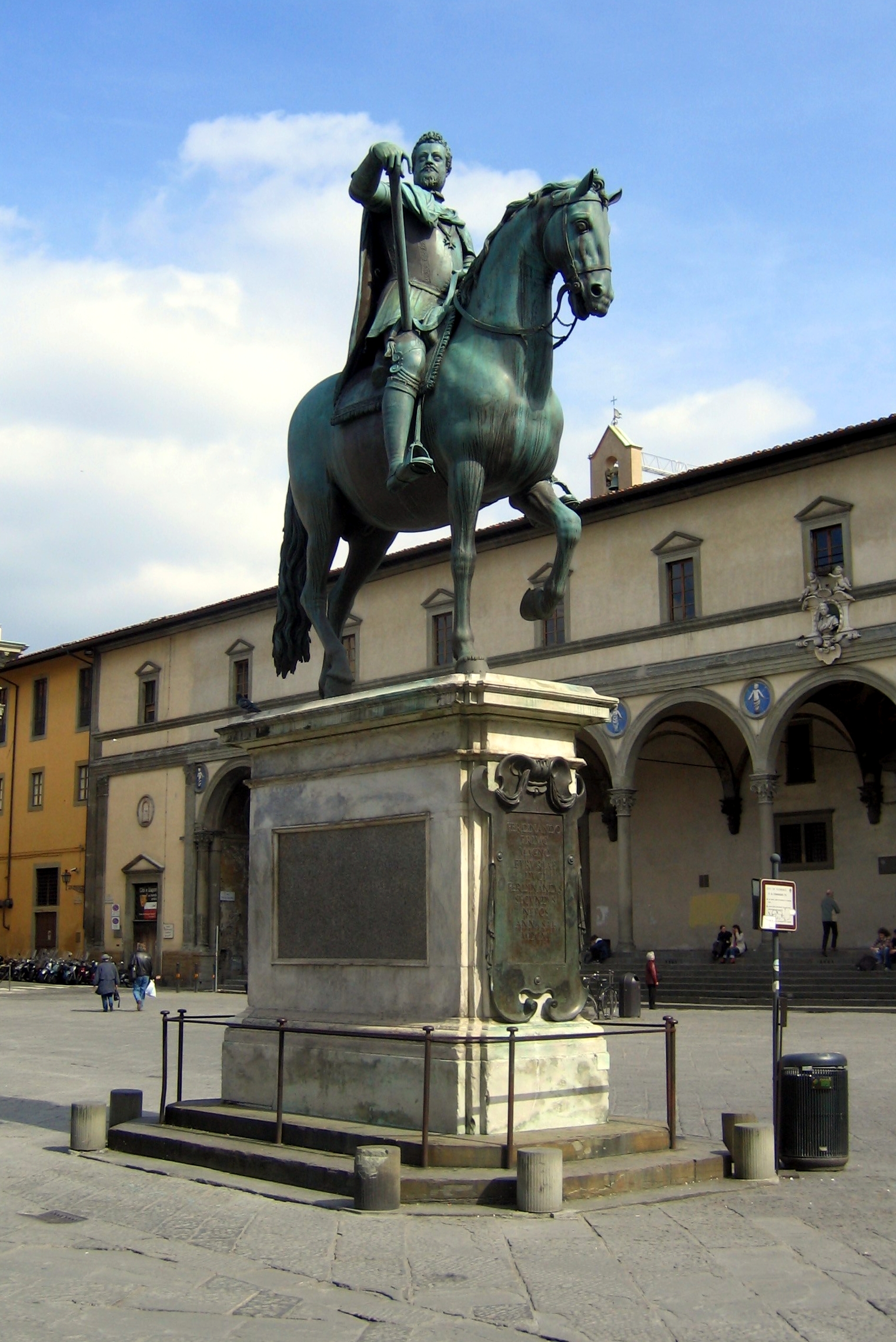Equestrian Statue Of Ferdinando I on:
[Wikipedia]
[Google]
[Amazon]
 The Equestrian Monument of Ferdinando I is a bronze equestrian statue by
The Equestrian Monument of Ferdinando I is a bronze equestrian statue by
Corografia dell'Italia
Volume 3, by Giovanni B. Rampoldi, page 1085. Flanking the statue some yards to the rear of the horse are two
 The Equestrian Monument of Ferdinando I is a bronze equestrian statue by
The Equestrian Monument of Ferdinando I is a bronze equestrian statue by Giambologna
Giambologna (1529 – 13 August 1608), also known as Jean de Boulogne (French), Jehan Boulongne (Flemish) and Giovanni da Bologna (Italian), was the last significant Italian Renaissance sculptor, with a large workshop producing large and small ...
, executed in 1602–1607, and erected in 1608 in the Piazza of the Annunziata in Florence
Florence ( ; ) is the capital city of the Italy, Italian region of Tuscany. It is also the most populated city in Tuscany, with 362,353 inhabitants, and 989,460 in Metropolitan City of Florence, its metropolitan province as of 2025.
Florence ...
, region of Tuscany
Tuscany ( ; ) is a Regions of Italy, region in central Italy with an area of about and a population of 3,660,834 inhabitants as of 2025. The capital city is Florence.
Tuscany is known for its landscapes, history, artistic legacy, and its in ...
, Italy
Italy, officially the Italian Republic, is a country in Southern Europe, Southern and Western Europe, Western Europe. It consists of Italian Peninsula, a peninsula that extends into the Mediterranean Sea, with the Alps on its northern land b ...
.
History
The monument was commissioned byCosimo II
Cosimo II de' Medici (12 May 1590 – 28 February 1621) was Grand Duke of Tuscany from 1609 until his death. He was the elder son of Ferdinando I de' Medici, Grand Duke of Tuscany, and Christina of Lorraine.
For the majority of his 12-year re ...
, son of Ferdinando I de' Medici, Grand Duke of Tuscany
Ferdinando I de' Medici, Grand Duke of Tuscany (30 July 1549 – 17 February 1609) was Grand Duke of Tuscany from 1587 to 1609, having succeeded his older brother Francesco I, who presumably died from malaria.
Early life
Ferdinando was the ...
, from an elder Giambologna
Giambologna (1529 – 13 August 1608), also known as Jean de Boulogne (French), Jehan Boulongne (Flemish) and Giovanni da Bologna (Italian), was the last significant Italian Renaissance sculptor, with a large workshop producing large and small ...
, and was meant to be modeled on the similar Equestrian statue of Cosimo I
The Equestrian Monument of Cosimo I is a bronze equestrian statue executed by Giambologna from 1587 to 1594, and erected in 1594 in the Piazza della Signoria in Florence, Tuscany, Italy.
History
This statue follows the Classical Roman tradition o ...
that stands in the Piazza della Signoria
() is a w-shaped Town Square, square in front of the in Florence, Central Italy. It was named after the Palazzo della Signoria, also called . It is the main point of the origin and history of the Florentine Republic and still maintains its reput ...
.
This project was mainly completed by his pupil Pietro Tacca
Pietro Tacca (16 September 1577 – 26 October 1640) was an Italian sculptor, who was the chief pupil and follower of Giambologna. Tacca began in a Mannerist style and worked in the Baroque style during his maturity.
Biography
Born in Carr ...
, and the statue was cast in 1602 and inaugurated at the site in 1608 during the festivities celebrating the marriage of Prince Cosimo II with Maria Maddalena d'Austria.
Grandduke Ferdinand wears armour emblazoned on the chest with the Cross of Santo Stefano, an equestrian Order established by Cosimo the elder. It is said the statue was cast with cannons taken from the Turks by the Knights of Santo Stefano.Volume 3, by Giovanni B. Rampoldi, page 1085. Flanking the statue some yards to the rear of the horse are two
mannerist
Mannerism is a style in European art that emerged in the later years of the Italian High Renaissance around 1520, spreading by about 1530 and lasting until about the end of the 16th century in Italy, when the Baroque style largely replaced it ...
fountains with marine gargoyles, the Fontana dei mostri marini
The two fontane dei mostri marini ("sea monster fountains") are located in the Piazza della Santissima Annunziata in Florence, Italy.
History
The two fountains were placed in 1641 at the sides of the Santissima Annunziata plaza, having been commi ...
, also created by Tacca though initially intended to be placed at the statue of Ferdinand in Livorno
Livorno () is a port city on the Ligurian Sea on the western coast of the Tuscany region of Italy. It is the capital of the Province of Livorno, having a population of 152,916 residents as of 2025. It is traditionally known in English as Leghorn ...
.
References
{{DEFAULTSORT:Equestrian Monument Ferdinando Equestrian statues in Tuscany Monuments and memorials in Florence Bronze sculptures in Florence Outdoor sculptures in Florence Sculptures by Giambologna 1600s sculptures Statues of monarchs Sculptures of men in Italy